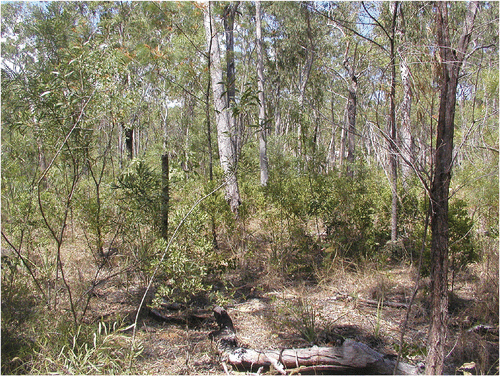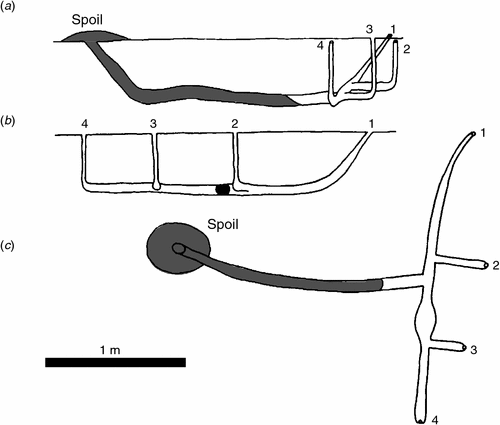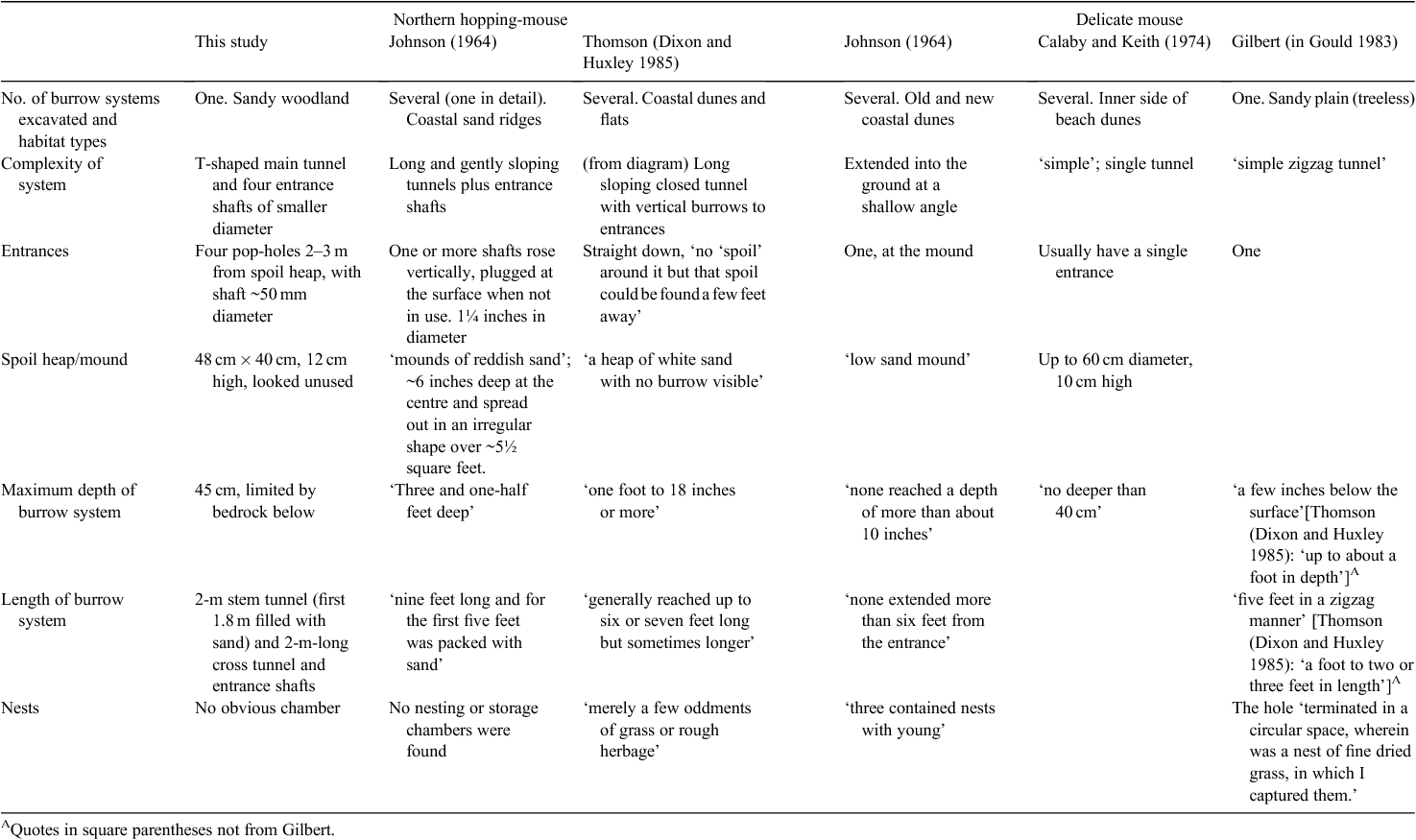Structure of a burrow of the northern hopping-mouse, Notomys aquilo, and its surface signs on Groote Eylandt
Simon J. WardNT Department of Land Resource Management, PO Box 1120, Alice Springs, NT 0871, Australia. Email: simon.ward@nt.gov.au
Australian Mammalogy 36(1) 55-59 https://doi.org/10.1071/AM13013
Submitted: 1 May 2013 Accepted: 5 September 2013 Published: 8 November 2013
Abstract
Identification of surface signs of burrows is becoming central to monitoring programs for the northern hopping-mouse. A burrow system was excavated in a sandy woodland area of Groote Eylandt to confirm it was used by northern hopping-mice, describe its structure, and relate structure to surface signs. The burrow was T-shaped, ~2 m long and wide, and connected to four vertical shafts leading to pop-hole-entrances/exits. The depth of the burrow was constrained by a rocky layer ~0.5 m below the surface. It was occupied by five hopping-mice, three of which were caught. The burrow systems dug by northern hopping-mice are more complex and extensive than those of delicate mice, Pseudomys delicatulus, and the major surface signs (spoil heaps or mounds) left by northern hopping-mice are unmarked by entrances or tracks, whereas those of delicate mice are marked by an entrance and trackways (if occupied).
Additional keywords: delicate mouse, mound, Pseudomys delicatulus, spoil, tunnel.
Introduction
The northern hopping-mouse, Notomys aquilo, is the only species of hopping-mouse in the wet–dry tropical ‘Top End’ and the only species that occurs outside of Australia’s arid and semiarid zones. It is a threatened species, listed as ‘Vulnerable’ under the Commonwealth Environmental Protection and Biodiversity Conservation Act 1999 and in the Northern Territory under the Territory Parks and Wildlife Conservation NT Act 2000 (Woinarski 2004), and there is growing interest in methods to monitor the species and its distribution, particularly in relation to assessment of mining impacts (Firth 2008; Smith 2010). The species is rarely trapped (Johnson 1964) or identified while spotlighting (pers. obs.) and current monitoring is almost entirely based on detection of putative burrows.
The northern hopping-mouse is restricted to areas with sandy substrates and Woinarski et al. (1999) showed that the species has a preference for habitats supporting floristically diverse heathlands and/or grasslands close to the coast. More recent studies have shown that it can also be common in woodland habitats with a diverse understorey (Ward 2009). The northern hopping-mouse shares these habitats on Groote Eylandt and in north-eastern Arnhem Land with the slightly smaller delicate mouse, Pseudomys delicatulus. Both species live in groups and occupy burrow systems dug in sandy substrates. Johnson (1964) and Thomson (Dixon and Huxley 1985) each dug up several hopping-mouse burrow systems on Groote Eylandt and provide some description of these systems, and Dixon and Huxley (1985) reproduce a field sketch by Thomson of one such burrow.
This note provides a detailed description of a northern hopping-mouse burrow system excavated on Groote Eylandt in September 2007. It compares measurements and other characters of the excavated burrow with previous descriptions by Johnson and Thomson and with descriptions of the burrows of the delicate mouse to aid in the correct identification of surficial burrow signs.
Locating the burrow system
The surface sign of the burrow system (the spoil heap or mound) was one of 21 found while surveying 30 transects (each 200 m long, but in a 50 m × 50 m square) in flat sandy woodland areas near Kings Crossing (‘Enungwadena’) (Fig. 1), close to the middle of the island (Ward 2009). The sand in the spoil heap was a white-orange colour that contrasted with the grey, more weathered, sand covering the surface of the ground. The spoil heap was ovoid in shape, ~48 cm across the longest dimension and 40 cm across the shortest; the highest point was ~12 cm above the surface. Hopping-mice had previously been located by spotlight ~650 m from the location. The excavation was made to confirm that this low pile of sand, with no obvious associated burrow entrance, was a spoil heap of a northern hopping-mouse burrow, and to confirm its use by northern hopping-mice (a species that the Indigenous land owners (Anindilyakwa Rangers) assisting in the excavation had not seen before).

|
The surface of the ground in the area around the spoil heap was scattered with leaf litter and we searched for hopping-mouse tracks but found none. The surface signs did not look recently formed, so when digging began it was not clear whether the burrow system had been occupied in recent times. Whilst searching the area for tracks and other signs, Rangers brushed away leaves on the ground and found four possible pop-holes some 3–4 m away from the spoil heap. Two of these were later found to connect with the burrow.
Excavation
A trench was dug down alongside one of the potential pop-holes (numbered ‘1’ in Fig. 2). Approximately 40 cm down, this descending shaft connected to the end of a horizontal tunnel. Following this tunnel, ~50 cm from the first shaft, there was a branch outward and upward to a second pop-hole (previously found on the surface). As excavation of the horizontal tunnel continued, three hopping-mice burst from a previously unseen pop-hole and were chased by Rangers. Two of the three hopping-mice were captured by hand. Digging recommenced and another two hopping-mice jumped out of another unseen pop-hole. One of these hopping-mice was captured. The horizontal tunnel was confirmed to connect with these two other pop-holes and with a perpendicular tunnel that headed towards the spoil heap. Much of this perpendicular tunnel was filled with sand. No more hopping-mice were found when the full extent of the burrow system was exposed.

|
The hopping mice we caught were two males and a female. The body mass, length of head, head–body, tail length, hindfoot, and ear, and the length and width of the scrotum (in males) were measured (Pesola 60 ± 0.5 g spring balance; vernier callipers ± 0.1 mm) and are reported in Table 1. The female was imperforate.

|
The form and dimensions of the burrow system
The burrow system was ‘T’-shaped in plan-view, with the spoil heap at the base of the ‘T’ and four pop-holes spaced out along the top bar of the ‘T’ (Fig. 2). The stem and bar of the ‘T’ were both ~2 m long. From the spoil heap, the initial tunnel (now filled with sand for the first 1.8 m) sloped down, then flattened out, and most of the burrow system was 40–45 cm deep, just above a layer of laterite bedrock. This tunnel was 80–90 mm in diameter. It led to approximately the middle of the main tunnel forming the top bar of the ‘T’, also 80–90 mm in diameter. The main tunnel had a vertical tunnel and pop hole at one end and narrowed and sloped up to a pop-hole at the other end. Two other short horizontal tunnels led off the tunnel at the top of the ‘T’, each ending in a vertical shaft and pop-hole. The pop-holes and shafts were ~50 mm in diameter, as were the short horizontal tunnels leading to them. There was no obvious expansion in the burrow system to form a nesting chamber, and no evidence of any nesting material.
Discussion
The ‘T’-shape of the burrow system excavated here, its four pop-hole entrances and its considerable length of tunnels and entrance shafts, make it more complex and extensive than previously reported for this species (Table 2) or for hopping-mouse burrows in general (Watts and Aslin 1981; Breed and Ford 2007). The depth of this burrow in sandy eucalypt woodland on Groote Eylandt (45 cm) was considerably shallower than typically reported previously but this depth was constrained by the bedrock; previous reports come from coastal sand dunes and flats (Table 2). Other characters of the burrow system reiterate those reported previously by Thomson (in Dixon and Huxley 1985) and Johnson (1964): the spoil heap covers the point where construction of the main tunnel system commenced and the upper one metre or more of this initial tunnel is filled with sand; entrance to and from the burrow is via narrow near-vertical shafts connecting pop-holes on the surface to the main tunnel; these pop-holes have no spoil around them and may be plugged when not in use; and, there may be little or no nesting material or nesting chamber. Woinarski and Flannery (2008) describe the nest as rudimentary, comprising no more than a few scraps of vegetation in an enlarged part of the burrow, but note that in captivity northern hoping-mice may make more elaborate nests.
Several of the characters described above and in Table 2 help distinguish a northern hopping-mouse burrow from that of a delicate mouse, two species that use similar habitats on Groote Eylandt and Arnhem Land (Johnson 1964; Dixon and Huxley 1985). Delicate mice use simpler and shallower burrow systems; typically a single entrance (associated with a spoil heap at the surface) leading to a single (sometimes zigzag) tunnel that descends at a shallow angle, reaching 1–2 m from the entrance and not more than 40 cm below the surface (Johnson 1964; Calaby and Keith 1974; Dixon and Huxley 1985).
The signs at the surface of a burrow system underneath are restricted to the spoil heap and the entrances. The spoil heap created when delicate mice dig a burrow will be marked by an entrance hole and is likely to bear the tracks of delicate mice. In contrast, when northern hopping-mice dig a burrow system, the initial point of digging is covered by the spoil heap (Table 2) and subsequent entrance and exit is via pop-holes. As a consequence, the spoil heap of an active hopping-mouse burrow shows no evidence of an entrance hole, is unlikely to exhibit hopping-mouse tracks and may appear old and weathered. The pop holes are often 1–2 m away from the spoil heap and are difficult to locate due to the hopping-mouse habit of plugging them with sand (Johnson 1964) and, especially in sandy woodland, the accumulation of litter (see Fig. 1). The accumulation of litter also makes it difficult to see tracks in these woodland habitats (pers. obs.). Johnson (1964) and Thomson (in Dixon and Huxley 1985) noted large numbers of hopping-mouse tracks in some areas of coastal dunes and flats. Large numbers of tracks are no longer evident in such habitat on Groote Eylandt (Ward 2009), probably due to the decline in numbers of the species. Johnson and Thomson described seeing and catching large numbers of hopping-mice relatively quickly, something that is no longer possible today (Woinarski 2004).
Excavation of a burrow system is very destructive and deprives the occupants of a home, so should not be repeated often. However, this note provides description of the surficial signs of the burrows of northern hopping-mice that can be used to identify whether hopping-mice occur in particular habitats or areas. Monitoring the numbers of spoil heaps along transects is currently the best technique for assessing presence and relative abundance of northern hopping-mice (Firth 2008; Ward 2009; Smith 2010). The power and usefulness of such monitoring will be greatly enhanced if future studies can establish how long signs of burrow systems (i.e. spoil heaps) remain visible and how long burrow systems remain occupied.
Acknowledgements
First, my thanks to the Anindilyakwa, the traditional owners of Groote Eylandt, for allowing me to carry out this study on their land. ALC Rangers Simon Hartley, Keith Lambert, Simeon Lalara, Russell Lalara, Gregson Lalara, Nathan Bara, Varren Lalara, Phillip Mamarika, David Campbell, Eliezer Mamarika and Elma Yantarrnga, and NRETAS staff Jenny Low Choy and Taegan Calnan all helped in the excavation of the burrow. Also many thanks to Simon Hartley, Linda Hughes and their ALC ranger team for logistical support and all the help they gave throughout the larger project. Thanks also to Brydie Hill, Beth Crase and Jane Edwards (NRETAS/DLRM) for work on previous field trips. Comments from John Woinarski and an anonymous reviewer resulted in significant improvements to the manuscript. The work was part of a larger project funded by the Australian Government through the Natural Heritage Trust.
References
Breed, B., and Ford, F. (2007). ‘Native Mice and Rats.’ (CSIRO Publishing: Melbourne.)Calaby, J. H., and Keith, K. (1974). Mammals. In ‘Fauna Survey of the Port Essington District, Cobourg Peninsula, Northern Territory of Australia’. (Eds H. J. Frith and J. H. Calaby.) pp. 179–208. Division of Wildlife Research Technical Paper No. 28. (CSIRO: Australia.)
Dixon, J. M., and Huxley, L. (1985). ‘Donald Thomson’s Mammals and Fishes of Northern Australia.’ (Nelson: Melbourne.)
Firth, R. (2008). ‘Surveys for the Threatened Northern Hopping-mouse, Northern Quolls and Brush-tailed Rabbit-rat on GEMCO Eastern Exploration Leases (Groote Eylandt).’ (EWL Sciences: Darwin.)
Gould, J. (1983). ‘The Mammals of Australia, with Modern Notes by Joan M Dixon.’ (The Macmillan Company: Melbourne.)
Johnson, D. H. (1964). Mammals of the Arnhem Land expedition. In ‘Records of the American–Australian Scientific Expedition to Arnhem Land. Volume 4 Zoology’. (Ed. R. L. Specht.) pp. 427–515. (Melbourne University Press: Melbourne.)
Smith, J. (2010). ‘Surveys for Northern Hopping-mouse, Northern Quolls and Brush-tailed Rabbit-rat across Groote Eylandt.’ (EWL Sciences: Darwin.)
Ward, S. (2009). Survey protocol for the northern hopping-mouse Notomys aquilo. Northern Territory Department of Natural Resources, Environment, The Arts and Sport, Darwin. Available at: http://www.lrm.nt.gov.au/__data/assets/pdf_file/0012/10830/NHM_survey_protocol_Aug09.pdf
Watts, C. H. S., and Aslin, H. J. (1981). ‘The Rodents of Australia.’ (Angus & Robertson: Sydney.)
Woinarski, J. C. Z. (2004). National multi-species recovery plan for the Carpentarian antechinus Pseudantechinus mimulus, Butler’s dunnart Sminthopsis butleri and northern hopping-mouse Notomys aquilo, 2004–2009. Northern Territory Department of Infrastructure Planning and Environment, Darwin.
Woinarski, J. C. Z., and Flannery, T. F. (2008). Northern hopping-mouse Notomys aquilo Thomas, 1921. In ‘The Mammals of Australia. Third Edition’. (Eds S. Van Dyck and R. Strahan.) pp. 599–600. (Reed New Holland: Sydney.)
Woinarski, J. C. Z., Gambold, N., Wurst, D., Flannery, T. F., Smith, A. P., Chatto, R., and Fisher, A. (1999). Distribution and habitat of the northern hopping mouse, Notomys aquilo. Wildlife Research 26, 495–511.
| Distribution and habitat of the northern hopping mouse, Notomys aquilo.Crossref | GoogleScholarGoogle Scholar |



